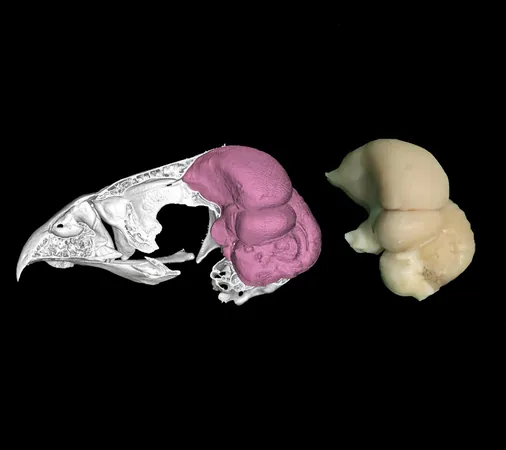
Unveiling the Secrets of Avian Intelligence: Breakthrough Study Redefines "Bird Brains"
2025-01-25
Author: Charlotte
For ages, the complexities of how birds think and process information have been shrouded in mystery. Unlike mammals, birds have not left behind fossilized brains, creating a significant challenge for researchers eager to explore their cognitive abilities across different eras. However, an innovative study conducted by evolutionary biologists in Australia and neuroscientists in Canada has heralded groundbreaking revelations regarding avian intelligence.
Researchers at Flinders University in South Australia and the University of Lethbridge in Canada have utilized cutting-edge digital technology to analyze bird skull structures, paving the way to study both extinct and modern avian species in detailed new ways. By creating digital "endocasts" from the cranial cavities of bird skulls, scientists can now estimate brain size and shape with incredible precision, providing a richer understanding of bird cognition and evolutionary history without the need for examining actual brain tissue.
Reconstructing Bird Brains Digitally
Published in the journal *Biology Letters,* this research focuses on reconstructing the internal structures of bird brains through advanced imaging techniques. By scanning preserved museum specimens from various bird species, scientists have uncovered detailed information about their neurological architecture. This includes insights into the size of essential brain regions responsible for cognitive functions such as intelligence and motor skills.
Lead author Aubrey Keirnan, a PhD researcher at Flinders University, remarks, "This research revealed an astonishing correlation between the imprint left by a bird's brain on its skull and the actual size proportions of crucial brain structures." The study explored the relationship between the forebrain—linked to intelligence—and the cerebellum, which governs coordination, by analyzing the skulls of 136 bird species and comparing the data with existing scientific literature.
The Surprising Accuracy of Endocasts
To the researchers' astonishment, the correlation between the brain's volume and the surface area of the endocast proved to be nearly perfect. The use of computed microtomography to recreate these digital endocasts has enabled scientists to study rare and even extinct bird species without the need for preserved brains. Professor Vera Weisbecker from Flinders University explains, "This advancement allows us to gain insights into the neuroanatomy of elusive species without causing any destruction to their remains."
Transforming Avian Research Paradigms
This inventive method marks a pivotal shift in the study of avian neurology. Previous techniques were often invasive and damaging to rare specimens, while this non-destructive scanning approach allows for the creation of digital models that can easily be shared within the scientific community and beyond. As collaborative efforts around these digital endocasts grow, researchers can embark on extensive comparative studies to track evolutionary patterns and uncover how different bird species developed their unique cognitive capabilities.
Implications for Evolution and Conservation
One of the most compelling aspects of this research is its potential impact on our understanding of avian intelligence evolution. By assessing the brain structures of diverse bird species, scientists can glean insights into the evolution of cognitive traits over millions of years. Co-lead professor Andrew Iwaniuk expressed his surprise at how well the endocasts reflected actual brain structures, emphasizing the new possibilities for future studies.
Moreover, this methodology offers vital implications for the conservation of endangered bird species. With many such species difficult to study in natural habitats, analyzing museum specimens could yield essential information regarding their cognitive abilities and social behaviors. The research could even provide insights into the cognitive characteristics of historical bird relatives, such as dinosaurs, though this remains a challenge.
A Bright Future for Avian Neuroscience
This groundbreaking study exemplifies significant progress in the realms of avian neuroscience and evolutionary biology. As researchers utilize advanced imaging technologies, the potential to analyze bird brains expands, shifting our understanding of intelligence in the avian kingdom. The findings against the stereotype of “bird brains” indicate an unexpected depth of cognitive ability and adaptability among these creatures.
As additional species are studied using digital endocasts, the scientific community anticipates uncovering even more fascinating relationships between avian brain structures and intelligence. The implications of this research are far-reaching, hinting at a more interconnected and intelligent world among our feathered friends than previously thought.
The study's findings are essential reading for anyone interested in the evolving understanding of animal cognition and the potential for future discoveries that could reshape our perspectives on wildlife intelligence.









 Brasil (PT)
Brasil (PT)
 Canada (EN)
Canada (EN)
 Chile (ES)
Chile (ES)
 Česko (CS)
Česko (CS)
 대한민국 (KO)
대한민국 (KO)
 España (ES)
España (ES)
 France (FR)
France (FR)
 Hong Kong (EN)
Hong Kong (EN)
 Italia (IT)
Italia (IT)
 日本 (JA)
日本 (JA)
 Magyarország (HU)
Magyarország (HU)
 Norge (NO)
Norge (NO)
 Polska (PL)
Polska (PL)
 Schweiz (DE)
Schweiz (DE)
 Singapore (EN)
Singapore (EN)
 Sverige (SV)
Sverige (SV)
 Suomi (FI)
Suomi (FI)
 Türkiye (TR)
Türkiye (TR)
 الإمارات العربية المتحدة (AR)
الإمارات العربية المتحدة (AR)